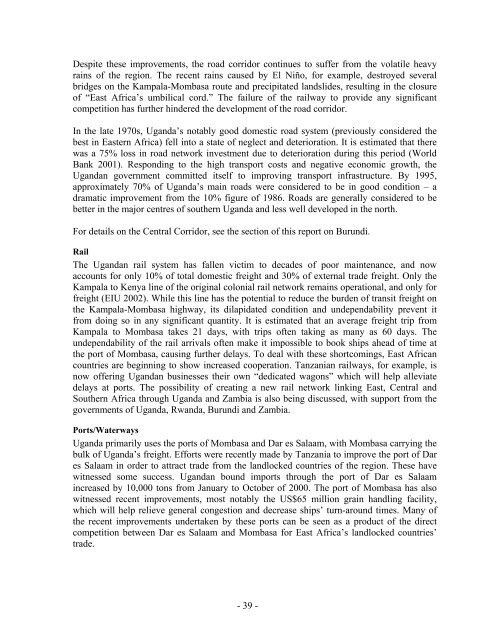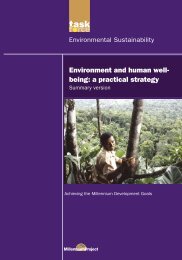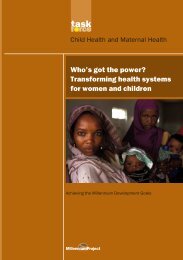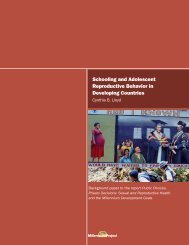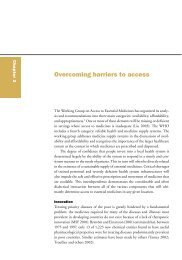the challenges facing landlocked developing countries: a case study ...
the challenges facing landlocked developing countries: a case study ...
the challenges facing landlocked developing countries: a case study ...
You also want an ePaper? Increase the reach of your titles
YUMPU automatically turns print PDFs into web optimized ePapers that Google loves.
Despite <strong>the</strong>se improvements, <strong>the</strong> road corridor continues to suffer from <strong>the</strong> volatile heavy<br />
rains of <strong>the</strong> region. The recent rains caused by El Niño, for example, destroyed several<br />
bridges on <strong>the</strong> Kampala-Mombasa route and precipitated landslides, resulting in <strong>the</strong> closure<br />
of “East Africa’s umbilical cord.” The failure of <strong>the</strong> railway to provide any significant<br />
competition has fur<strong>the</strong>r hindered <strong>the</strong> development of <strong>the</strong> road corridor.<br />
In <strong>the</strong> late 1970s, Uganda’s notably good domestic road system (previously considered <strong>the</strong><br />
best in Eastern Africa) fell into a state of neglect and deterioration. It is estimated that <strong>the</strong>re<br />
was a 75% loss in road network investment due to deterioration during this period (World<br />
Bank 2001). Responding to <strong>the</strong> high transport costs and negative economic growth, <strong>the</strong><br />
Ugandan government committed itself to improving transport infrastructure. By 1995,<br />
approximately 70% of Uganda’s main roads were considered to be in good condition – a<br />
dramatic improvement from <strong>the</strong> 10% figure of 1986. Roads are generally considered to be<br />
better in <strong>the</strong> major centres of sou<strong>the</strong>rn Uganda and less well developed in <strong>the</strong> north.<br />
For details on <strong>the</strong> Central Corridor, see <strong>the</strong> section of this report on Burundi.<br />
Rail<br />
The Ugandan rail system has fallen victim to decades of poor maintenance, and now<br />
accounts for only 10% of total domestic freight and 30% of external trade freight. Only <strong>the</strong><br />
Kampala to Kenya line of <strong>the</strong> original colonial rail network remains operational, and only for<br />
freight (EIU 2002). While this line has <strong>the</strong> potential to reduce <strong>the</strong> burden of transit freight on<br />
<strong>the</strong> Kampala-Mombasa highway, its dilapidated condition and undependability prevent it<br />
from doing so in any significant quantity. It is estimated that an average freight trip from<br />
Kampala to Mombasa takes 21 days, with trips often taking as many as 60 days. The<br />
undependability of <strong>the</strong> rail arrivals often make it impossible to book ships ahead of time at<br />
<strong>the</strong> port of Mombasa, causing fur<strong>the</strong>r delays. To deal with <strong>the</strong>se shortcomings, East African<br />
<strong>countries</strong> are beginning to show increased cooperation. Tanzanian railways, for example, is<br />
now offering Ugandan businesses <strong>the</strong>ir own “dedicated wagons” which will help alleviate<br />
delays at ports. The possibility of creating a new rail network linking East, Central and<br />
Sou<strong>the</strong>rn Africa through Uganda and Zambia is also being discussed, with support from <strong>the</strong><br />
governments of Uganda, Rwanda, Burundi and Zambia.<br />
Ports/Waterways<br />
Uganda primarily uses <strong>the</strong> ports of Mombasa and Dar es Salaam, with Mombasa carrying <strong>the</strong><br />
bulk of Uganda’s freight. Efforts were recently made by Tanzania to improve <strong>the</strong> port of Dar<br />
es Salaam in order to attract trade from <strong>the</strong> <strong>landlocked</strong> <strong>countries</strong> of <strong>the</strong> region. These have<br />
witnessed some success. Ugandan bound imports through <strong>the</strong> port of Dar es Salaam<br />
increased by 10,000 tons from January to October of 2000. The port of Mombasa has also<br />
witnessed recent improvements, most notably <strong>the</strong> US$65 million grain handling facility,<br />
which will help relieve general congestion and decrease ships’ turn-around times. Many of<br />
<strong>the</strong> recent improvements undertaken by <strong>the</strong>se ports can be seen as a product of <strong>the</strong> direct<br />
competition between Dar es Salaam and Mombasa for East Africa’s <strong>landlocked</strong> <strong>countries</strong>’<br />
trade.<br />
- 39 -


